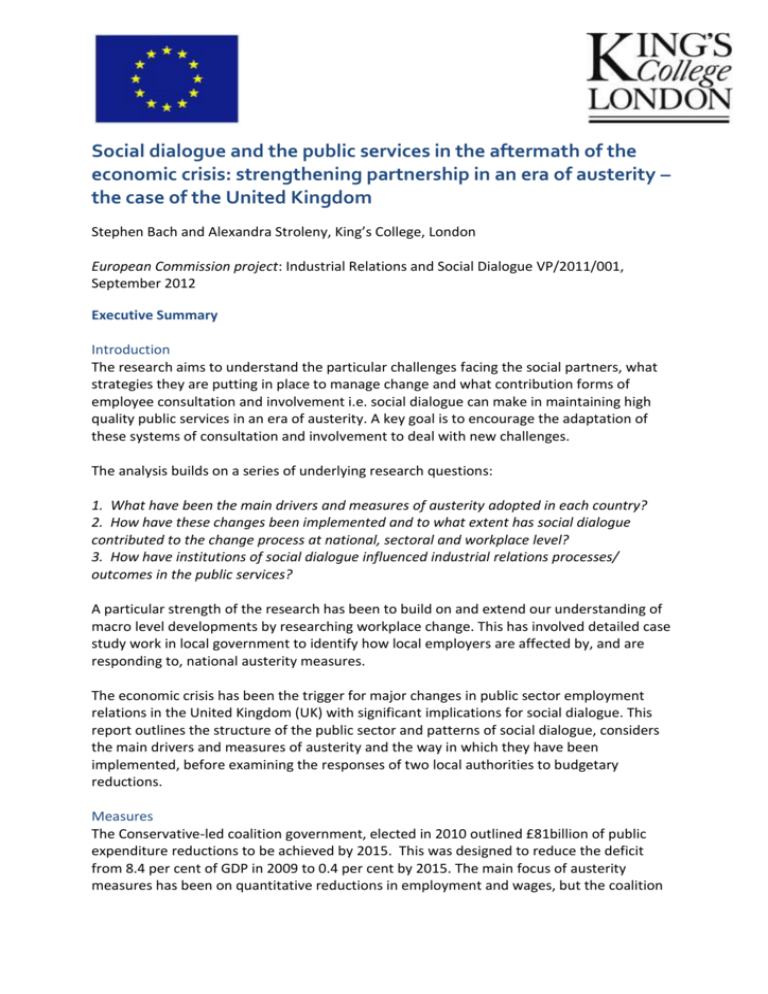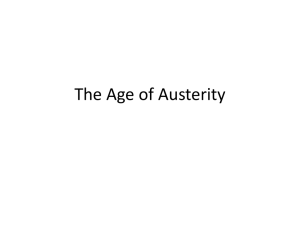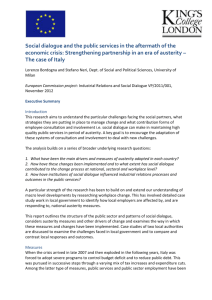UK-Executive-Summary - King`s College London
advertisement

Social dialogue and the public services in the aftermath of the economic crisis: strengthening partnership in an era of austerity – the case of the United Kingdom Stephen Bach and Alexandra Stroleny, King’s College, London European Commission project: Industrial Relations and Social Dialogue VP/2011/001, September 2012 Executive Summary Introduction The research aims to understand the particular challenges facing the social partners, what strategies they are putting in place to manage change and what contribution forms of employee consultation and involvement i.e. social dialogue can make in maintaining high quality public services in an era of austerity. A key goal is to encourage the adaptation of these systems of consultation and involvement to deal with new challenges. The analysis builds on a series of underlying research questions: 1. What have been the main drivers and measures of austerity adopted in each country? 2. How have these changes been implemented and to what extent has social dialogue contributed to the change process at national, sectoral and workplace level? 3. How have institutions of social dialogue influenced industrial relations processes/ outcomes in the public services? A particular strength of the research has been to build on and extend our understanding of macro level developments by researching workplace change. This has involved detailed case study work in local government to identify how local employers are affected by, and are responding to, national austerity measures. The economic crisis has been the trigger for major changes in public sector employment relations in the United Kingdom (UK) with significant implications for social dialogue. This report outlines the structure of the public sector and patterns of social dialogue, considers the main drivers and measures of austerity and the way in which they have been implemented, before examining the responses of two local authorities to budgetary reductions. Measures The Conservative-led coalition government, elected in 2010 outlined £81billion of public expenditure reductions to be achieved by 2015. This was designed to reduce the deficit from 8.4 per cent of GDP in 2009 to 0.4 per cent by 2015. The main focus of austerity measures has been on quantitative reductions in employment and wages, but the coalition has also used its emphasis on deficit reduction to reinforce qualitative, structural, reforms that build on and redirect aspects of the Labour government’s modernisation agenda. In particular the government has committed itself to shrink the state and increase the role of the private and voluntary sector in service provision. The coalition government set out its initial plans for public expenditure in an emergency budget in June 2010 that announced a two year wage freeze that it anticipated would save £3.3 billion by 2014-15 and plans to use a less favourable measure of inflation for indexing pensions. The public sector workforce is experiencing a four year period of pay restraint – two years of a pay freeze, followed by two years when pay awards are limited to an average 1 per cent. A two-year pay freeze on pay awards covers 2011-12 and 2012-2013 across all areas of the public sector with some protection for staff earning £21,000 or less (but not in local government). The coalition government has encouraged employers to change substantive terms and conditions (e.g. sick pay) and procedural agreements (e.g. trade union facilities time). The main instrument of austerity implementation has been via financial control, which in the highly centralised UK system of government, is tightly controlled by the Treasury. Local employers are required to achieve a balanced budget and have some discretion about how they reduce expenditure. Overall, the coalition government in office since 2010 has focused on fiscal consolidation by shrinking the state, cutting public expenditure and reducing public sector employment. Public sector headcount decreased by around 10 per cent between 2010-2012 with larger reductions in local government and the civil service. Reducing the structural deficit has therefore been translated into public sector employment reductions and wage moderation. This approach has left limited scope for dialogue with public sector trade unions at national level but the picture is more varied at sectoral and local level. Social Dialogue The term social dialogue is less commonly used in the UK and instead public sector analysis has focused on the distinctive, but changing, features of employee participation and trade union involvement in the public services. The UK model of public service employment relations is characterised by industry specific national agreements, in large bargaining units, with high levels of workforce coverage. Many aspects of work organisation, including the size and composition of the workforce and systems of employee involvement are largely left to employer discretion. There are relatively few legal obligations in terms of employee voice providing scope for local variation and differing levels of workforce involvement. This local flexibility is reinforced by central government policy which focuses on targets for expenditure reduction rather than centrally prescribed staffing levels. Social dialogue at the national level is very limited in a context of wage freezes. Although there has been some negotiation and consultation at sectoral level, the current context has limited the scope for agreement and created difficult industrial relations and challenges for government, employers and trade unions. Whilst much of the institutional architecture has remained intact so far, there is ongoing debate and proposals for pay reform. These proposals may strengthen national frameworks of pay determination by increasing flexibility, but trade unions suspect that they are intended to erode national pay 2 determination, restrict trade union involvement by strengthening managerial prerogatives and reinforce moves towards more individualised forms of performance management. At local level, as the case studies illustrate, there is scope for staff involvement and consultation that enables local productivity deals and can ameliorate the negative effects of austerity. However, while in some cases the delegation of responsibility for cuts has reinforced social dialogue, albeit in a context of concession bargaining, other local authorities have looked towards more unilateral cuts in terms and conditions. Local Government Local government has been hit hard by budgetary reductions but the responsibility lies with each authority in terms of how they respond. Local government is not within the remit of the government’s public sector pay and therefore has greater scope to depart from government pay policy, if financial circumstances permit. This autonomy, however, is in practice highly constrained, given local government’s dependence on central government funding and the requirement on each authority to balance its budget. There has been some difference in response from the sector, but this has actually resulted in a lengthier period of pay restraint than other sub-sectors. Local government employers had already decided not to make a pay offer in 2010, even before the coalition government decided to impose a two year pay freeze. In 2011 the local government employers made no pay offer and this was extended into an unprecedented third year. A dilemma for trade unions is that in the absence of any national pay increase and falling living standards, there is some membership pressure to negotiate at local level which could erode the national agreement. At local level, there have been some straightforward changes that the majority of local authorities have introduced, such as reducing mileage rates for car users, but there are significant variations in the approach adopted by local authorities, linked to the degree of financial stress councils are facing, their political complexion and variations in managerial strategies. Undoubtedly local authorities have confronted some of the most difficult financial challenges in the public sector and this has been reflected in their willingness in some cases to impose new terms and conditions on staff if agreement cannot be reached. Given the scale of the budgetary reductions, local authorities have also targeted headcount. A variety of other responses are being used to restructure the workforce and reduce workforce costs. First, a common first step has been to implement a vacancy freeze and to tighten up on the use of temporary and agency staffing. Second, local authorities are engaging in a variety of partnerships with collaboration in sharing services. Many local authorities are using shared services models to share HR, legal and other services. Some local authorities have gone further and considered wholesale outsourcing of services, but the level of risk involved and the potential loss of managerial control has led to reconsideration and some scaling back in plans for wholesale outsourcing. Some local authorities see more scope for savings by engaging with their workforce, generating internal efficiencies and have brought some services back in-house whilst re-engineering the way services are delivered. Third, some councils have developed sophisticated redeployment models to minimise job losses whilst ensuring that the council employs staff with the right skills. Finally, given the scale of cuts councils are retrenching and focusing on statutory services, leading to the downgrading or withdrawing of services, such as youth services. 3 Conclusion Public services have been subject to a continuous process of reform for more than three decades. Nonetheless, the advent of an era of austerity is forcing changes in employment relations that draw on earlier phases of Conservative and Labour government reform but which are now being pursued with more vigour. What is distinctive about the current approach is the speed and depth of the austerity measures. Austerity measures already have had significant implications in quantitative terms in terms of employment reductions. Terms and conditions have also been affected. Predominantly, employers have focused on those terms and conditions which are more straightforward to change locally such as premium pay and car allowances. However, employers also target other terms and conditions, such as sick pay, which trade unions have been traditionally very resistant to negotiate on as this threatens to undermine national collective bargaining. Although there have been few wage cuts, a two-year pay freeze across the public sector, followed by a two-year 1 per cent cap as well as changes to the pension system have been implemented. At the national level there has been no dialogue with employers or trade unions on the formation of government plans, such as dialogue prior to the announcement of the wage freeze. Whilst there has been very limited consultation with the social partners over the austerity measures adopted, there has been consultation and negotiation at sectoral level. Sectoral level social dialogue has been more important in reaching agreement on issues such as pension reform and changes in reward systems. At local level dialogue has been more evident, but very much geared to responding to employer proposals for budgetary reductions. At local level, employers have placed more emphasis on direct communication and involvement of their workforce. There are examples of cases where discussions have led to concessions and trade-offs between the relevant parties albeit employers have been more willing to impose changes in terms of conditions than in the past. The coalition government has had much less engagement with public sector trade unions at national level than its predecessor, but it has maintained formal institutional linkages between the trade unions and government. However, although most of the institutional architecture of social dialogue remains in place, as collective bargaining has been effectively suspended, trade unions express strong frustration at their inability to influence a government that is viewed as unreceptive to trade union arguments. Key Sources/ references: Bach, S. (2012). ‘Shrinking the State or The Big Society? Public Service Employment Relations in an era of Austerity’, Industrial Relations Journal, 43(5): 399-415. Bach, S. and Kessler, I. (2012). The Modernisation of the Public Services and Employee Relations: Targeted Change. London: Palgrave Macmillan. Treasury (2010) Spending Review 2010. London: The Stationery Office. 4









